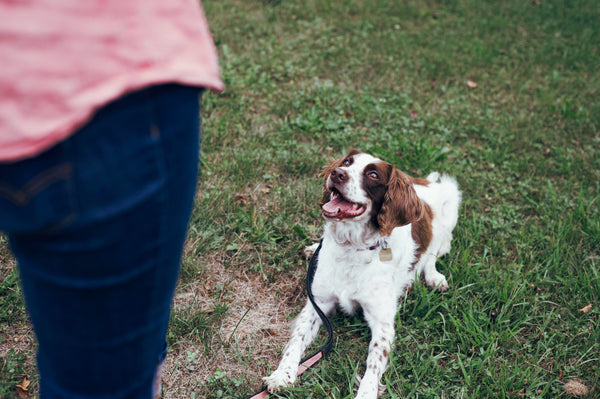Dog training is an essential aspect of building a strong bond and effective communication between you and your furry companion. Clicker training is a powerful way to teach your dog new tricks and tasks, and can also be used to discourage unwanted behaviours by teaching your dog to do something appropriate instead. In this article, we will explore what clicker training is, its benefits, and how you can implement it to train your dog effectively.

What To Teach First:
Eye contact on cue will help you get your dog's attention, even in a distracting area, before asking for another behaviour. Start in a low distraction area (like your living room), say, "Watch me," just once, and simply wait for your dog to look at you. When they do, click and reward them with a treat. At first, it can be helpful to bring the treat up to your eyes to guide your dog into looking directly at your face. You can phase this out by turning it into a hand signal. Try this a couple of times indoors, then try it in a slightly more interesting area, such as your backyard. When your dog gets the hang of that, you can try it during walks around the block, at the park, and inside a pet store. Also try gradually increased distances. It'll be easy to get your dog to watch you when you're right in front of them. Try it when you're a few metres away, then across the room. When you're making a task more challenging, only focus on one area: increase distance OR distractions, not both at once, so you can set your dog up for success. By now, your dog will have a strong understanding of what the click means, so you can move on to more advanced tasks.
Introduce the Clicker:
Begin by associating the sound of the clicker with rewards. Click the clicker and immediately give your dog a treat. Repeat this process several times until your dog starts to anticipate the treat when they hear the click. There's three primary ways of teaching your dog a new behaviour: luring, capturing and shaping.
Luring:
Luring is the technique most commonly used by beginning dog trainers, and that's only because it's so effective. Many professional trainers use luring too, but they realise that you can become too dependent on it, so it should be phased out quickly. An example of luring would be to put a treat in front of your dog's nose, then slowly wave it around in a circle so that they'll follow it, doing a spin in the process.
Capturing:
Capturing means to click and reward your dog when they perform a desired behaviour naturally without being prompted. For example, if you want your dog to yawn on cue, you can simply wait until they are tired. When they yawn, you'll click and reward them. After you capture a few yawns with your clicker, you'll start to say the cue, "sleepy," when your dog is mid-yawn, just before you click and reward them. This technique can take time because you'll have to wait until your dog performs the behaviour on their own, but as your dog gets the hang of clicker training, they'll catch on faster and faster. That's why consistent training is so important. It strengthens the bond between you and your dog so you're able to continually communicate more effectively with them. You can teach complex tricks using a combination of these techniques.

Shaping
Shaping is a more advanced technique and it demands precision - which is why the clicker is so useful for it. As an example, let's say you wanted to teach your dog to step up onto a chair. You would place the chair in front of the dog, and wait for them to approach it. You would click and reward the dog a few times just for going near it. Of course, the dog will continue to approach the chair when they realize that going near it is highly rewarding. Then, you'll up your criteria by waiting for the dog to touch it. Then, you'll click and reward when your dog puts one paw on it, then two paws, and finally, when your dog steps up onto it. Shaping can be difficult for both the dog and trainer at first. It requires very precise timing, and your dog may be at first confused. After you train a simple trick through shaping, though, your dog will start to realize that you will reward them when they make an effort. So, they'll be motivated to use their problem-solving skills to figure out how to get closer to the desired behaviour.
Phasing Out The Clicker
You don't need to have your clicker handy every time you want your dog to sit. The clicker is just for making it easier to teach new tricks. Once your dog learns to do a behaviour on cue, you don't need to click before rewarding. It's perfectly fine to use praise and verbal markers like "good!" at times. By focusing on positive reinforcement and clear communication, you can help your dog reach their full potential while enjoying the learning process together. With patience, consistency, and plenty of treats, you'll be amazed at what you and your furry friend can achieve through clicker training.



